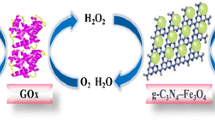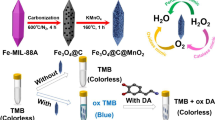Abstract
A self-sacrificing catalytic method is described for the preparation of magnetic core/dual-functional-shell nanocomposites composed of magnetite, gold and Prussian Blue (type Fe3O4@Au-PB). Two reaction pathways are integrated. The first involves chemical dissolution of Fe3O4 (the self-sacrificing step) by acid to release ferrous ions which then reacts with hexacyanoferrate(IV) to generate PB in the proximity of the magntic nanoparticles (MNPs). The second involves the reduction of tetrachloroaurate by hydroxylamine to generate gold under the catalytic effect of the MNPs. At the end, the MNPs@Au-PB nanocomposite is formed. This method exploits both the chemical reactivity and catalytic effect of the MNPs in a single step. The multi-function material was applied (a) in an optical assay for H2O2; (b) in an amperometric assay for H2O2; (c) in an enzymatic choline assay using immobilized choline oxidase. The limit of electrochemical detection of H2O2 (at a potential as low as 50 mV) is 1.1 μM which is comparable or better than most analogous methods. The sensors display superior performance compared to the use of conventional core@single-shell (MNPs@PB) nanomaterials.

A self-sacrificing catalytic method is described to prepare magnetic core/dual-functional-shell nanocomposites composed of magnetic nanoparticle, gold and Prussian Blue (type MNP@Au-PB). The nanocomposites work well as candidates to develop colorimetric and electrochemical sensors of H2O2 with superior performance to analogues.






Similar content being viewed by others
Change history
18 June 2019
The online version has been available; however, the corrections that have been suggested in a separate file apart from e.proofing were not carried out. Given here is the corrected article.
References
Urbanova V, Magro M, Gedanken A, Baratella D, Vianello F, Zboril R (2014) Nanocrystalline Iron oxides, composites, and related materials as a platform for electrochemical, magnetic, and chemical biosensors. Chem Mater 26(23):6653–6673. https://doi.org/10.1021/cm500364x
Tuček J, Kemp KC, Kim KS, Zbořil R (2014) Iron-oxide-supported Nanocarbon in lithium-ion batteries, medical, catalytic, and environmental applications. ACS Nano 8(8):7571–7612. https://doi.org/10.1021/nn501836x
Wu L, Mendoza-Garcia A, Li Q, Sun S (2016) Organic phase syntheses of magnetic nanoparticles and their applications. Chem Rev 116(18):10473–10512. https://doi.org/10.1021/acs.chemrev.5b00687
Gao J, Gu H, Xu B (2009) Multifunctional magnetic nanoparticles: design, synthesis, and biomedical applications. Acc Chem Res 42(8):1097–1107. https://doi.org/10.1021/ar9000026
Xiao D, Lu T, Zeng R, Bi Y (2016) Preparation and highlighted applications of magnetic microparticles and nanoparticles: a review on recent advances. Microchim Acta 183(10):2655–2675. https://doi.org/10.1007/s00604-016-1928-y
Zou C, Fu Y, Xie Q, Yao S (2010) High-performance glucose amperometric biosensor based on magnetic polymeric bionanocomposites. Biosens Bioelectron 25(6):1277–1282. https://doi.org/10.1016/j.bios.2009.10.014
Zhang Q, Li L, Qiao Z, Lei C, Fu Y, Xie Q, Yao S, Li Y, Ying Y (2017) Electrochemical conversion of Fe3O4 magnetic nanoparticles to electroactive Prussian blue analogues for self-sacrificial label biosensing of avian influenza virus H5N1. Anal Chem 89(22):12145–12151. https://doi.org/10.1021/acs.analchem.7b02784
Bordage AL, Moulin R, Fonda E, Fornasieri G, Riviére E, Bleuzen A (2018) Evidence of the Core-shell structure of (Photo)magnetic CoFe prussian blue analogue nanoparticles and peculiar behavior of the surface species. J Am Chem Soc 140(32):10332–10343. https://doi.org/10.1021/jacs.8b06147
Fu G, Liu W, Li Y, Jin Y, Jiang L, Liang X, Feng S, Dai Z (2014) Magnetic Prussian blue nanoparticles for targeted Photothermal therapy under magnetic resonance imaging guidance. Bioconjug Chem 25(9):1655–1663. https://doi.org/10.1021/bc500279w
Zhao G, Feng J-J, Zhang Q-L, Li S-P, Chen H-Y (2005) Synthesis and characterization of Prussian blue modified magnetite nanoparticles and its application to the Electrocatalytic reduction of H2O2. Chem Mater 17(12):3154–3159. https://doi.org/10.1021/cm048078s
Ma Y, Xu G, Wei F, Cen Y, Xu X, Shi M, Cheng X, Chai Y, Sohail M, Hu Q (2018) One-pot synthesis of a magnetic, Ratiometric fluorescent Nanoprobe by encapsulating Fe3O4 magnetic nanoparticles and dual-emissive rhodamine B modified carbon dots in Metal-organic framework for enhanced HClO sensing. ACS Appl Mater Interfaces 10(24):20801–20805. https://doi.org/10.1021/acsami.8b05643
Sadiq MM, Li H, Hill AJ, Falcaro P, Hill MR, Suzuki K (2016) Magnetic induction swing adsorption: an energy efficient route to porous adsorbent regeneration. Chem Mater 28(17):6219–6226. https://doi.org/10.1021/acs.chemmater.6b02409
Chen Y, Xiong Z, Peng L, Gan Y, Zhao Y, Shen J, Qian J, Zhang L, Zhang W (2015) Facile preparation of Core-Shell magnetic Metal-organic framework nanoparticles for the selective capture of Phosphopeptides. ACS Appl Mater Interfaces 7(30):16338–16347. https://doi.org/10.1021/acsami.5b03335
Kobayashi H, Mitsuka Y, Kitagawa H (2016) Metal nanoparticles covered with a Metal-organic framework: from one-pot synthetic methods to synergistic energy storage and conversion functions. Inorg Chem 55(15):7301–7310. https://doi.org/10.1021/acs.inorgchem.6b00911
Chen L, Li H, Zhan W, Cao Z, Chen J, Jiang Q, Jiang Y, Xie Z, Kuang Q, Zheng L (2016) Controlled encapsulation of flower-like Rh-Ni alloys with MOFs via tunable template Dealloying for enhanced selective hydrogenation of alkyne. ACS Appl Mater Interfaces 8(45):31059–31066. https://doi.org/10.1021/acsami.6b11567
Fu Y, Callaway Z, Lum J, Wang R, Lin J, Li Y (2014) Exploiting enzyme catalysis in ultra-low ion strength Media for Impedance Biosensing of avian influenza virus using a bare interdigitated electrode. Anal Chem 86(4):1965–1971. https://doi.org/10.1021/ac402550f
Afkhami A, Shirzadmehr A, Madrakian T, Bagheri H (2014) Improvement in the performance of a Pb 2 + selective potentiometric sensor using modified core/shell SiO 2 /Fe 3 O 4 nano-structure. J Mol Liq 199:108–114
Bagheri H, Afkhami A, Sabertehrani M, Khoshsafar H (2012) Preparation and characterization of magnetic nanocomposite of Schiff base/silica/magnetite as a preconcentration phase for the trace determination of heavy
Bagheri H, Asgharinezhad AA, Ebrahimzadeh H (2016) Determination of trace amounts of cd(II), cu(II), and Ni(II) in food samples using a novel functionalized magnetic Nanosorbent. Food Anal Methods 9(4):876–888
Bagheri H, Yamini Y, Safari M, Asiabi H, Karimi M, Heydari A (2016) Simultaneous determination of pyrethroids residues in fruit and vegetable samples via supercritical fluid extraction coupled with magnetic solid phase extraction followed by HPLC-UV. J Supercrit Fluids 107:571–580
Bagheri H, Pajooheshpour N, Afkhami A, Khoshsafar H (2016) Fabrication of a novel electrochemical sensing platform based on a core–shell nano-structured/molecularly imprinted polymer for sensitive and selective determination of ephedrine. RSC Adv 6(56):51135–51145
Yin PT, Pongkulapa T, Cho H-Y, Han J, Pasquale NJ, Rabie H, Kim J-H, Choi J-W, Lee K-B (2018) Overcoming Chemoresistance in Cancer via combined MicroRNA therapeutics with anticancer drugs using multifunctional magnetic Core-Shell nanoparticles. ACS Appl Mater Interfaces 10(32):26954–26963. https://doi.org/10.1021/acsami.8b09086
Zirak M, Garegeshlagi EJ (2018) Picolinimidoamide-Cu(II) complex anchored on Fe3O4@SiO2 core-shell magnetic nanoparticles: an efficient reusable catalyst for click reaction. J Coord Chem 71(8):1168–1179. https://doi.org/10.1080/00958972.2018.1450975
Moorthy MS, Subramanian B, Panchanathan M, Mondal S, Kim H, Lee KD, Oh J (2017) Fucoidan-coated core-shell magnetic mesoporous silica nanoparticles for chemotherapy and magnetic hyperthermia-based thermal therapy applications. New J Chem 41(24):15334–15346. https://doi.org/10.1039/c7nj03211k
Hegazy M, Zhou P, Wu G, Wang L, Rahoui N, Taloub N, Huang X, Huang Y (2017) Construction of polymer coated core-shell magnetic mesoporous silica nanoparticles with triple responsive drug delivery. Polym Chem 8(38):5852–5864. https://doi.org/10.1039/c7py01179b
Sun L, Li Q, Hou M, Gao Y, Yang R, Zhang L, Xu Z, Kang Y, Xue P (2018) Light-activatable Chlorin e6 (Ce6)-imbedded erythrocyte membrane vesicles camouflaged Prussian blue nanoparticles for synergistic photothermal and photodynamic therapies of cancer. Biomater Sci 6(11):2881–2895. https://doi.org/10.1039/C8BM00812D
Wang T, Fu Y, Chai L, Chao L, Bu L, Meng Y, Chen C, Ma M, Xie Q, Yao S (2014) Filling carbon nanotubes with Prussian blue nanoparticles of high peroxidase- like catalytic activity for colorimetric Chemoand biosensing. Chem Eur J 20(9):2623–2630. https://doi.org/10.1002/chem.201304035
Wang T, Fu Y, Bu L, Qin C, Meng Y, Chen C, Ma M, Xie Q, Yao S (2012) Facile synthesis of Prussian blue-filled multiwalled carbon nanotubes nanocomposites: exploring filling/electrochemistry/mass-transfer in Nanochannels and cooperative biosensing mode. J Phys Chem C 116(39):20908–20917. https://doi.org/10.1021/jp306492a
Farka ZK, Čunderlová V, Horáčková V, Pastucha M, Mikušová Z, Hlaváček A, Skládal P (2018) Prussian blue nanoparticles as a catalytic label in a Sandwich Nanozyme-linked immunosorbent assay. Anal Chem 90(3):2348–2354. https://doi.org/10.1021/acs.analchem.7b04883
Jiang Y, Wang W, Li X, Wang X, Zhou J, Mu X (2013) Enzyme-mimetic catalyst-modified Nanoporous SiO2-cellulose hybrid composites with high specific surface area for rapid H2O2 detection. ACS Appl Mater Interfaces 5(6):1913–1916. https://doi.org/10.1021/am400253d
Huang J, Zhu Y, Zhong H, Yang X, Li C (2014) Dispersed CuO nanoparticles on a silicon nanowire for improved performance of nonenzymatic H2O2 detection. ACS Appl Mater Interfaces 6(10):7055–7062. https://doi.org/10.1021/am501799w
Zhang Y, Bai X, Wang X, Shiu K-K, Zhu Y, Jiang H (2014) Highly sensitive Graphene-Pt nanocomposites Amperometric biosensor and its application in living cell H2O2 detection. Anal Chem 86(19):9459–9465. https://doi.org/10.1021/ac5009699
Song M, Wang J, Chen B, Wang L (2017) A facile, nonreactive hydrogen peroxide (H2O2) detection method enabled by ion chromatography with UV detector. Anal Chem 89(21):11537–11544. https://doi.org/10.1021/acs.analchem.7b02831
Deng C, Li M, Xie Q, Liu M, Tan Y, Xu X, Yao S (2006) New glucose biosensor based on a poly(o-phenylendiamine)/glucose oxidase-glutaraldehyde/Prussian blue/Au electrode with QCM monitoring of various electrode-surface modifications. Anal Chim Acta 557(1):85–94. https://doi.org/10.1016/j.aca.2005.10.009
Harish S, Joseph J, Phani KLN (2011) Interaction between gold (III) chloride and potassium hexacyanoferrate (II/III)—does it lead to gold analogue of Prussian blue? Electrochim Acta 56(16):5717–5721. https://doi.org/10.1016/j.electacta.2011.04.044
Jiang Y, Yu S, Wang B, Li Y, Sun W, Lu Y, Yan M, Song B, Dou S (2016) Prussian blue@C composite as an ultrahigh-rate and long-life sodium-ion battery cathode. Adv Funct Mater 26(29):5315–5321. https://doi.org/10.1002/adfm.201600747
Carvalho, CLC, Silva, ATB, Luz RAS, Castro GMB, da Luz Lima C, Mastelaro VR, da Silva RR, Oliveira ON, Cantanhêde W (2018) Development of Co3[Co(CN)6]2/Fe3O4 bifunctional nanocomposite for clinical sensor applications. ACS Appl Nano Mater: https://doi.org/10.1021/acsanm.8b01106
Ma S, Zhan S, Jia Y, Zhou Q (2015) Superior antibacterial activity of Fe3O4-TiO2 Nanosheets under solar light. ACS Appl Mater Interfaces 7(39):21875–21883. https://doi.org/10.1021/acsami.5b06264
Bratescu MA, Cho S-P, Takai O, Saito N (2011) Size-controlled gold nanoparticles synthesized in solution plasma. J Phys Chem C 115(50):24569–24576. https://doi.org/10.1021/jp207447c
Ono LK, Roldan Cuenya B (2008) Formation and thermal stability of Au2O3 on gold nanoparticles: size and support effects. J Phys Chem C 112(12):4676–4686. https://doi.org/10.1021/jp711277u
Dai H, Li Y, Zhang Q, Fu Y, Li Y (2018) A colorimetric biosensor based on enzyme-catalysis-induced production of inorganic nanoparticles for sensitive detection of glucose in white grape wine. RSC Adv 8(59):33960–33967. https://doi.org/10.1039/C8RA06347H
Acknowledgements
This work was supported by National Natural Science Foundation of China (Grants 21505120, 21775137), and the State Key Laboratory of Chemo/Biosensing and Chemometrics.
Author information
Authors and Affiliations
Corresponding author
Ethics declarations
The author(s) declare that they have no competing interests.
Additional information
Publisher’s note
Springer Nature remains neutral with regard to jurisdictional claims in published maps and institutional affiliations.
Electronic supplementary material
ESM 1
(DOC 1032 kb)
Rights and permissions
About this article
Cite this article
Li, Y., Liu, J., Fu, Y. et al. Magnetic-core@dual-functional-shell nanocomposites with peroxidase mimicking properties for use in colorimetric and electrochemical sensing of hydrogen peroxide. Microchim Acta 186, 20 (2019). https://doi.org/10.1007/s00604-018-3116-8
Received:
Accepted:
Published:
DOI: https://doi.org/10.1007/s00604-018-3116-8




